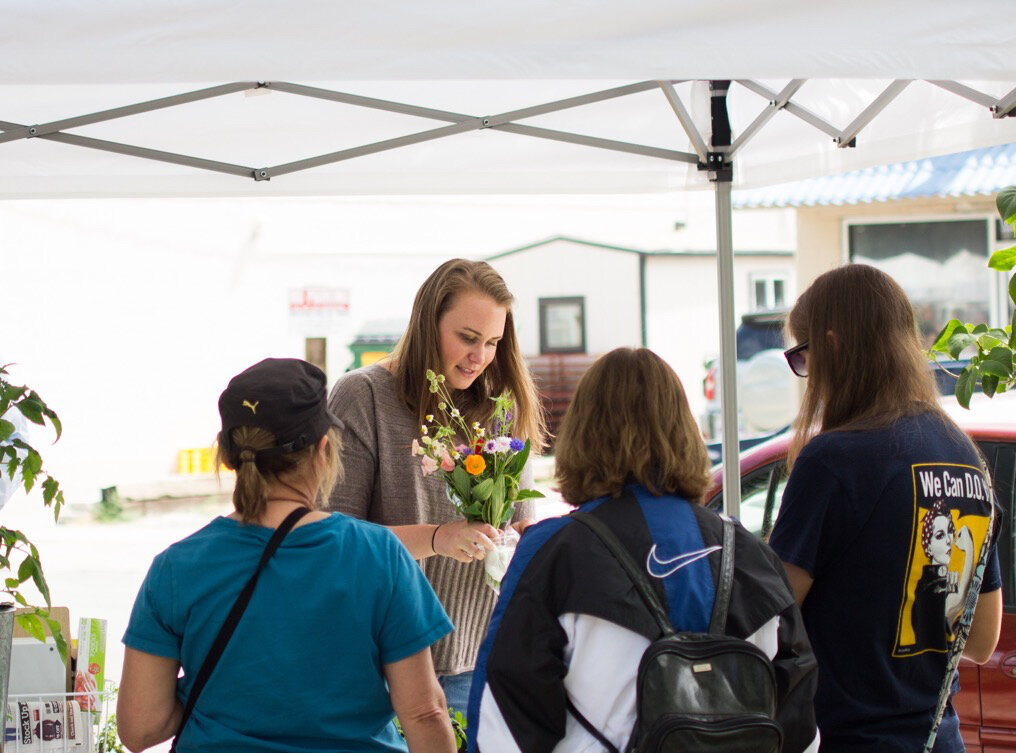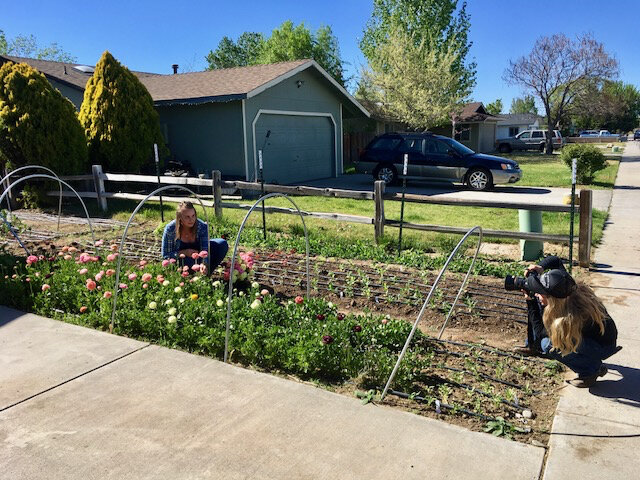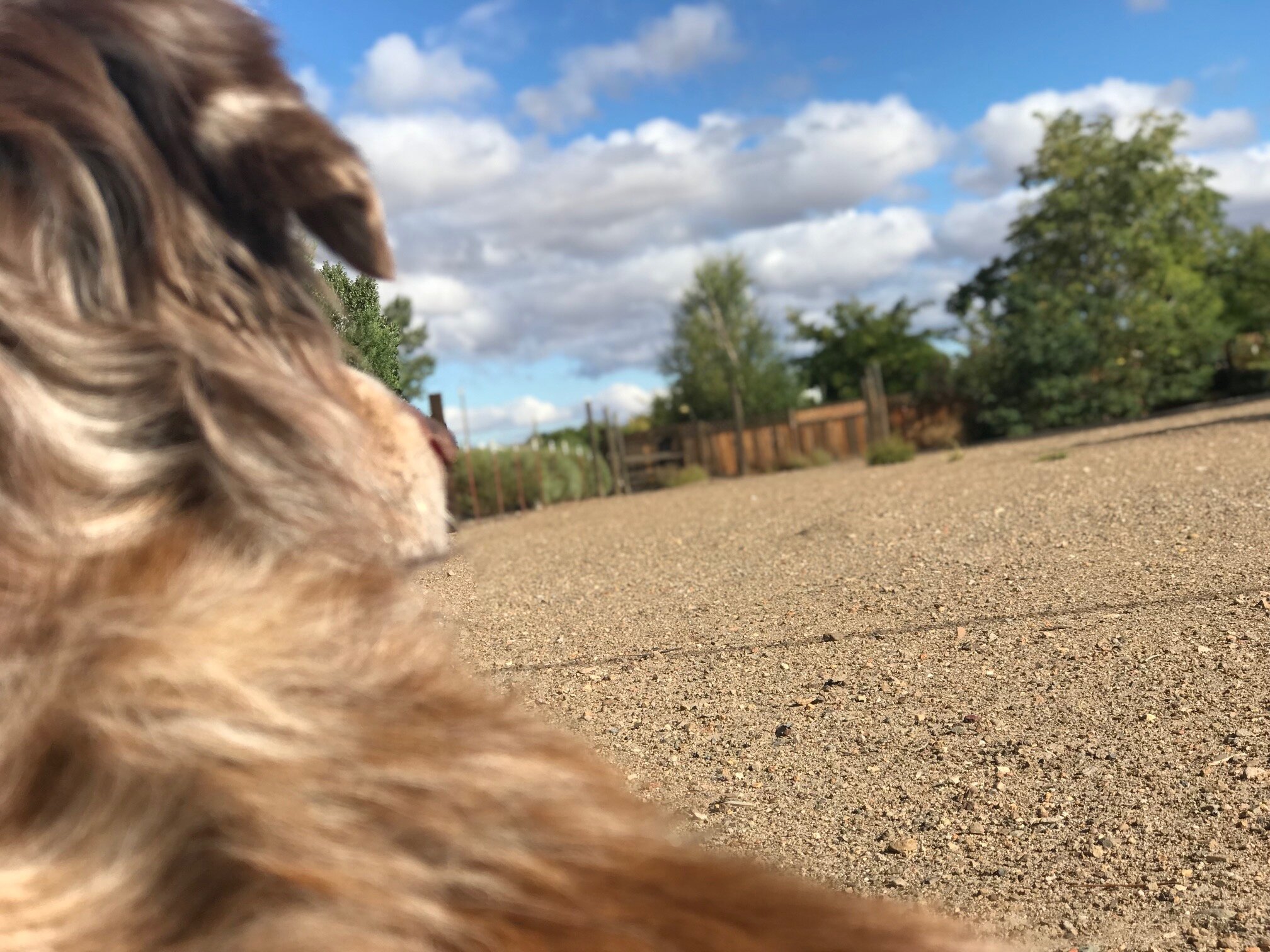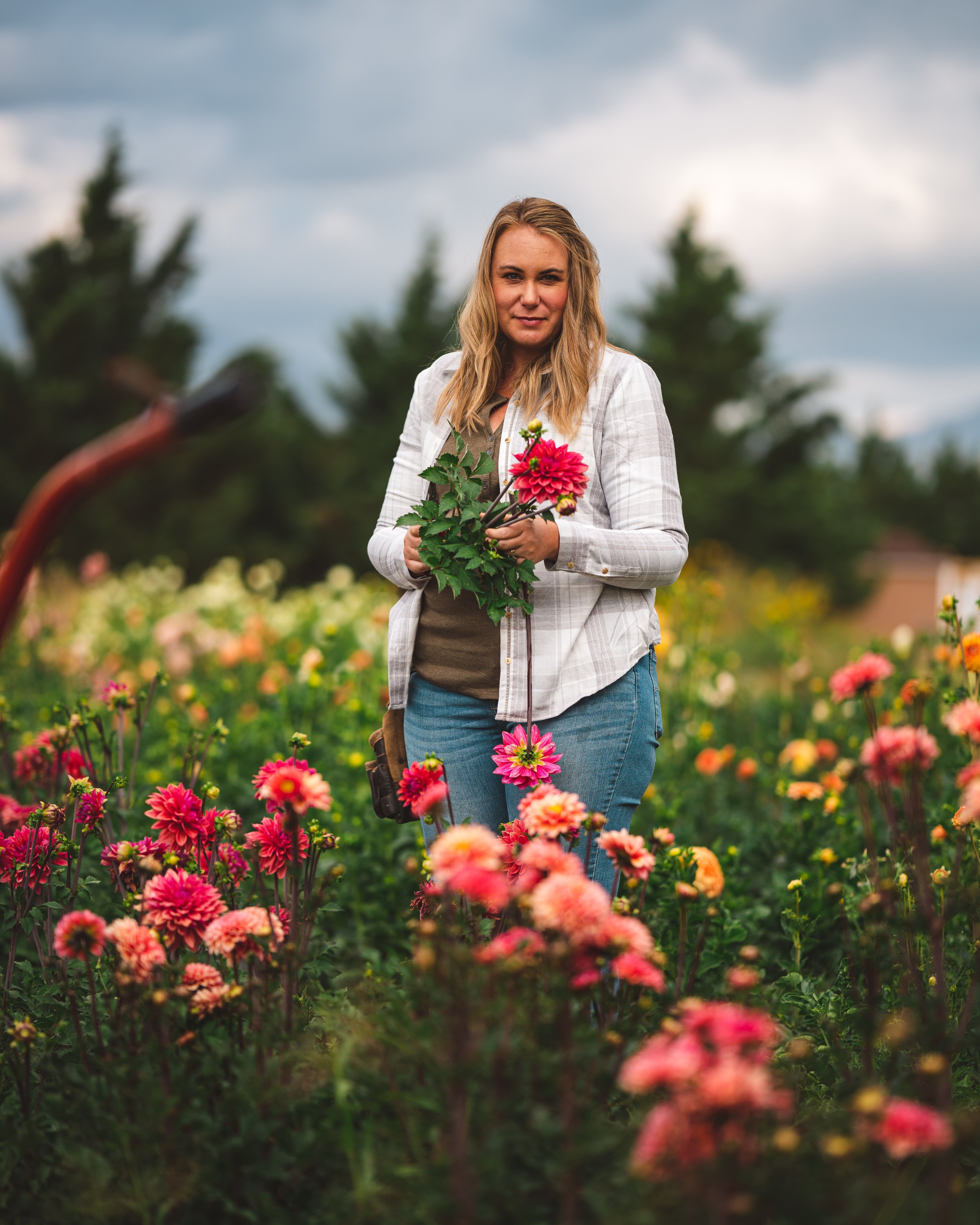Starting a Flower Farm on a Shoestring Budget
Disclaimer: This site contains affiliate links of products we wholehearted believe in. Your purchases through these links help us bring you more valuable flower farming content. Thank you for your support!
You want to be a flower farmer but you are quickly feeling like your dream is growing bigger than your bank account can handle.
Can you flower farm without buying plugs? Peony bare roots? A walk in cooler? Landscape fabric? Can you launch into this dream without investing in expensive courses, equipment and infrastructure?
The answer to all these is yes! Yes, you can dive into the world of flower farming without major investments. Major investments can make it nicer but is far from a requirement.
Flower farming, as I often say, is not a one size fits all. This is a mantra I learned the hard way and is the common theme throughout our blogs. Everyone has a different launching point. Perhaps you have tons of land but a limited budget. Perhaps you have a big budget but are limited on land. Perhaps you are limited on cash and land (that was our story!).
If you are willing to put the effort behind flower farming, and trust me there is a lot of effort that is demanded, you can start a flower farm even on a slim budget. Heck, even if you have money to throw at it, you should approach flower farming on a slim budget. That’s just business smart.
You made the emotional decision to start a flower farm but now it is time to approach it from a business stand point, because ultimately this will allow you to actually flower farm instead of just dreaming of flower farming. Slow and steady wins the race.
A little backstory for those of you who haven’t read our previous blogs. Here’s how Sierra Flower Farm came to be.
I wanted to flower farm.
My mom gifted me $1,000 and we used our tax refund, so all together we had about $2,000- $3,000 to start Sierra Flower Farm with.
We also only had about 1,600 square feet of hodgepodge growing space to work with that was full of large river rock.
In case you didn’t notice- our entire budget for first year flower farming wasn’t much more than one of the more popular online courses currently offered. Heck, back when we started online courses weren’t even a thing!
YouTube was lacking, and blogs other than some big flower farmers, were near non-existent. Growing for Market was super expensive because it was before they had the more affordable digital option, coming by information was tough. Coming by free information and wading through the good versus the dumb was even tougher.
There was a lot of trial and error. Definitely not a spoon-fed-road-map-to-a successful-flower- farm-business-model route. Fast forward five years later, we are still flower farming (it’s only growing in many ways!) and bonus: we are here to share our experiences, knowledge and be here to give you encouragement. Worth it.
If you want to learn more about our beginnings check out our blogs: Farmer-Florist, It’s a thing and Advice for the first year flower farmers and dreamers.
There is a lot to learn when starting a flower farming business
Learning to grow
Marketing
Floristry (even some basic bouquet making and variety selection takes some designer skills!)
Business
With each of these comes with a huge list of skills, tasks and decisions to be had. You don’t simply just “flower farm” you are now also an entrepreneur. A business owner and marketer. You are the salesperson, the communication person, delivery person, designer. All on top of being the one who is sowing seeds, planting, harvesting, soil preparing, crop planning etc. There are so many moving parts that it seems mind boggling- I get it, I’ve been there! I also want to mention, I had very minimal growing experience. I had limited skills in photography, never put together my own website or designed logos. All of this, with the support of my husband, we figured out as we went. I started the farm on a slim budget and with a negative 10 in experience in being in business or farming. I had two toddlers on top of the heap, there was obviously a lot of juggling. So when I say this is doable, I am also the example of this is doable. If you have the grit you are halfway there.
I assure you, that in time, all that I listed becomes second nature. I will never call it easy because being a business owner and flower farmer is not an easy road. Rewarding, invigorating, sure, but never easy. Being a business owner of any kind should never be “easy”, if it is it probably means your business isn’t growing! You aren’t growing! If you do approach it with everything you got you will be challenged physically, mentally and emotionally.
However, if you want to be a flower farmer, I promise it is completely worth it.
When starting a flower farm on a shoe string budget you will have to wear many hats to make it work. You have to pour yourself into this new venture, this new way of life, immerse yourself in it. Flower farming is a far cry from a get rich quick scheme, though it can be profitable and there are many flower farmers who have made it their living!
With all that said, here is our list of our top 4 recommendations/realities of how to start a flower farm on a budget.
Have a Budget for Your Flower Farm
There is a lot of investments to make. You will quickly see those add up. This is why you will need to watch those emotional/impulse purchases. They’ll getcha!
Set a budget for the year.
That is a really loose guideline. You also need to decide what your first year will be. Are you planning on having product spring-Christmas, or maybe summer only? As a flower farmer, you may find yourself putting in fall orders for the following year by June, which means paying for them come fall. Your budget needs to be able to cover those orders on top of all the upfront costs for the season and costs to keep the season rolling. It’s a lot.
If you haven’t decided that yet, check out our blog The Importance of Deciding on a Product Before Crop Planning to help you out.
As a first year flower farmer, you’re not going to have historical data to base this off of. It will be as simple as “how much can you put into this business?”
I recommend for starting a flower farm:
Going as debt free as possible
Don’t count on sales before you make them
Don’t blow your budget frivolously
Don’t give yourself so much of a budget that it is taking food from your mouth, get what I’m saying? I also recommend not counting your chickens before those eggs hatch. Don’t blow your budget in spring with the idea that you will make it up in summer. If you make those sales great, but it’s best not to rely on them. It will allow you to reinvest more, but realize that making those sales can go slow, it takes time to build a market.
You need to have your budget be able to cover all your expenses for the year. Depending on the budget, you may be finding yourself saying “no” to a lot of those desired purchases. Especially when it comes to purchasing tons of flower varieties! Make sure to keep in the back of your mind everything you need to get to be able to have product to sell in the end.
Let’s break this down a little further.
Where the Money Goes Starting a Flower Farming Business
Say you can swing $3,000 to start your flower farm.
That $3,000 is going to be split so many ways in growing supplies alone:
Seeds
Seed Starting Substrate
Seed Starting Supplies
Tubers, corms, bulbs
Soil Amendments
Soil Tests
Trellising
Fertilizers
Small tools
Equipment
Landscape Fabric
Irrigation supplies
Farming, is really not cheap. Especially if you are starting from scratch. Outside of growing supplies you need supplies for the selling of the flowers and post harvesting. Buckets, clippers, flower food, rubber bands, sleeves, etc.
You will also have business expenses: website, marketing materials (business cards, signs, stickers/stamps), fees (farmer’s market, inspections, other state requirements you may be subjected to), accounting programs, photography equipment, card readers, cash box, etc.
You may also decide that you want to invest in education: courses, books, memberships, subscriptions.
If you decide to leap into being a farmer-florist you will have other investments to make such as vessels, ribbon, pins, frogs, floral tape, etc.
You will be finding yourself needing to weigh every potential investment big and small. Don’t nickel and dime yourself with seeds and then not have the funds for a big load of quality compost. You will be playing the game of prioritizing purchases, the essentials versus the not super essential, though you might think EVERYTHING is essential.
If you don’t keep your finger on the pulse, you can easily find yourself overspending on every variety of Lisianthus that take months to produce or pricey bare root roses that won’t give you a return for at least two years. Be wise and approach your budget like it is limited, like that is all you have to run with.
To learn more about this topic be sure to check out our blog First year business plan budgeting for the flower farmer
To help you figure out your main product and sales read our blog on that topic here
Be lean in your expenditures for your flower farm
Those pre-made sleeves may sound easy enough but will your budget allow for it and do you really need over a thousand your first year? Is it the best investment for your money?
Buying plugs sounds way easier than starting the seeds themselves, but will your budget, and in turn sales, allow for it for the extra cost of them?
Paying for an online course sounds smarter than researching or trial and error by yourself, wouldn’t that save you money then? Perhaps…
Convenience comes with a price. There are a lot of gadgets and ways to spend money on that convenience for your flower farm. Some of those conveniences may even give you a much needed boost of confidence but if you choose that convenience will your budget stretch out the entire year?
Remember, you want to think in terms that you may not have incredible sales your first year. If you invest in all these, will you ultimately be able to then have something to actually sell by the end of it? Those seed catalogs and courses will make you dream big but come May, you will find money flying out with things that never crossed your mind! That money goes quick!
This is when you will go back to the budget you set, try your best to not bloat your budget in hopes that the return on investment will be worth it. Allow your flower farm to earn its keep.
Find more frugal ways to make your own sleeves, such as a cheap roll of painter paper and a roll-paper-ripper with a good ol’ rubber stamp all stapled together. It is quick and affordable. Don’t order plugs unless you are sure you can sell those flowers your first season at a profit. Try to start as much as you can from seed yourself. Only invest in a course if your budget is big enough to handle it along with all the other costs needed to actually flower farm and run a business.
A side note, if you can’t afford one of those courses- it is not the end of the world. Information is out there, it just takes a little time, and honestly you will find yourself researching all the time anyways. You never stop learning. Flower farming is not one size fits all, what works for them, their business model and even their climate might not be your case. This is where you work through your problems and your confines to find out what does work for you.
There is always a give and take. Sometimes you will be having to choose between what will make you more profitable, cash wise, over what is easier. Weight if the additional price for convenience saves you that much time in exchange for that cost.
You may not be able to afford to hire labor, hire a bookkeeper, hire a social media manager or marketing manager, you will find yourself taking on a lot of work and throwing in a lot of effort.
This leads me to our next reality.
Time is your flower farm’s currency
If you don’t have cash hopefully you have time because that has now become your currency. If you can’t throw money at the conveniences you will have to throw yourself at it. Your approaches may end up not being as lean as far as time but in the beginning, you may not have another option if you want this dream to lift off.
You may find yourself turning rows over by hand because you can’t swing the cost of a rototiller. You might find yourself weeding in between the plants because the upfront cost of landscape fabric would blow your budget. All of these approaches require your time and labor but if you don’t have the cash, what do you do?
You put your time into it.
You build your own website. You take your own photos. You sow your own seeds. You grow and sell only as much as you yourself can handle. If business ends up truly blowing up and you are losing actual sales, not potential ones but actual ones, turning people away or not having enough time to put together orders, then it is time to reassess.
Keep a running list of what to invest in next that will allow your business to be more profitable.
Think of the questions of whats really hampering you. Whether efficiency, quality, etc. Write it down. In time, the business will earn its keep and even though flower farming in general takes a lot of your time, it will earn cash to buy back some of your time. From mechanical seeder to walk in coolers, it will come.
Perhaps your budget will allow for those investments up front, but I’m not sure you’d be here reading on budget if that was the case. Be patient.
You’re Going to Need to Hustle for Your Flower Farm Dream
Time as your main currency can make for some really long days. The most budget friendly approach is for the business owner to hustle in the beginning, this is typical for most successful businesses.
Even hiring employees too soon might sink your ship before it leaves the dock. You will be tired. You will be overwhelmed. Hopefully, you have some friends and family who would like to help out, and will take flowers as payment!
The reality is, no one is going to hustle more than you. No one is going to be more genuine in sharing your brand’s story. No one is going to have the passion and grit for your business than you. Therefore, you need to pour your time into your budding business.
You will also need to put your own time into researching and learning. Even if you take a course. Once again, everyone has a different launching point, therefore, the research time will look different.
One of my favorite resources that’s free is actually Johnny Select Seeds and Bootstrap Farmer is growing in tons of resources they offer. Another affordable resource is Growing for Market. Book wise I would skip over the pretty ones and go for Specialty Cut Flower and the Post-harvesting to start with. They are expensive but are my main go to resources when I have questions on how to grow or harvest a variety properly. Every time you open the books you will learn something new. I also like to scribble my own notes in the books.
The bottom line, get used to researching.
If you don’t consider yourself a good researcher, start learning.
Problems will arise and you need to be able to go down the rabbit hole and know how to find answers. When you are flower farming, you are in the trenches. Only you can make a call on whether to take out a suspicious plant that may be diseased, why you’re seeing failure to thrive, when to plant out, how to plan out your crops in a timely fashion.
You may not be able to wait for lab results on a suspicious ranunculus plant. You have to decide whether the risk of planting out those seedlings given weather predictions will be worth it. You have to decide whether a plant is worth being left in the growing bed or should be ripped out because it’s just not thriving or its time to sow something else. There are resources and tools but you ultimately need to begin honing your own skills for some fast and thorough decision making. In time, it gets easier but new problems and challenges will always arise. You will be continuously adding new information into your arsenal.
The good news is, some of the tasks you find yourself putting time into your first year should hopefully be only once. Creating your brand, business set up, etc. There are tasks that will require a lot of upfront time but next season, should go a lot quicker such as crop planning.
Be patient with yourself and your allotted budget. Don’t get discouraged. Focus on your business plan, goals and sales. Don’t compare your set up or situation to other flower farmers.
Making a flower farm into a side hustle or more manageable while being profitable is absolutely doable, to read more on that check out our blog Flower farming as a side hustle.
All of this leads us to our last point.
Enjoying this content? Then be sure to connect with us over on Instagram and sign up for our Flower Farming Newsletter!
Now back to budgeting!
Bootstrapping for your flower farm
People make jokes about farmers using duct tape and baling twine as a fix all. The thing is, you are going to have to get creative and you might just be holding some things together with duct tape for a while.
The bottom line is, you are going to use what you have on hand and can get, to make it happen. This is bootstrapping my friends. What flower farming on a budget comes down to. Out-of-the-box solutions.
Creative solutions that you’re not going to see mainstream flower farmers promote. Not pretty or ideal but it gets it done.
They will say a walk in cooler is a must but a flower farmer who has the choice between a walk in cooler or being able to afford seeds and soil amendments is going to skip over the walk in cooler. And guess what? They make it work! An air-conditioned room, a cool basement. For us, we invested in a deep chest freezer with an Ink Bird controller to turn into a cooler.
Definitely not ideal but within one farmer’s market: we made our money back by the flowers we were able to store in it all week. These days we’ve outgrown it but we are now also at the point where the business has earned that walk in cooler that we should hopefully start building soon.
Can’t afford a hoop house? Low tunnels will be your friends! These are solutions that are less than perfect and may require more time but will be more affordable.
You might find yourself having to skip kit hoop houses or propagation houses. That comes back to that convenience factor. That’s been our story, luckily Graham has been able to figure out how to DIY a lot of tools and infrastructure. We figured out how to easily build our own hoop bender, propagation house and are just starting on finally building a high tunnel. The first two have been money makers for us with season extension and quality plant starts.
If building isn’t your strong suit or possible, then patience and having a budget is going to be the name of the game. My point is, for each problem you encounter, throwing large amounts of money doesn’t necessarily have to be the absolute solution. There is give and take, more time, less convenient but ultimately can be profitable and budget friendly.
How much of your effort or time are you willing to give?
You will find yourself revisiting and weighing your bootstrapping solutions, and when your business has outgrown those it is something to celebrate!
This means your business should be earning the upgrades that will up the level of your quality of life and cash will be more your currency than your time. That switch will slowly sneak up on you but you will feel good about making those investments when the time is right.
You do not need to have all the infrastructure, you do not need to have every book and course, you do not have to invest in luxury crops and plugs if your budget doesn’t allow for it. Allow your business to grow with you. Slowly. Sustainably. Start off with the essentials to get growing and selling, while always keeping in the back of your mind:
What do I need to get, to have something to sell?
Remember to always keep track of those moving pieces and get creative with your solutions. Have fun with the process and don’t get frustrated. Embrace the challenges and where you are.
The flowers will grow.
Your business will grow, give it time, and always remember it can happen on a budget.
Not everyone can afford to throw tons of cash at this new endeavor and that is okay. Own where you are and write down all your dreams and goals for your flower farm. Get it out. Then plan out your first year staying within your means. Your budget. Your abilities. Your time. Your creativity.
We are looking forward to helping you hand blooms soon!
- Jessica & Graham
Here are some of my favorite flower farming books on budgeting!
We feature only the companies and products we genuinely love and recommend, and all opinions expressed are our own. If you make a purchase through the links in this post, we may earn a small commission—thank you for supporting our flower farm!















